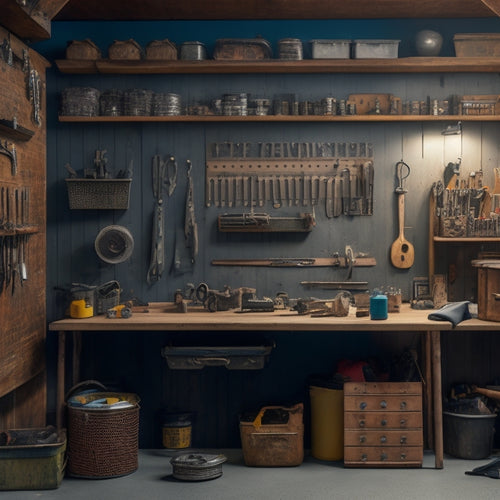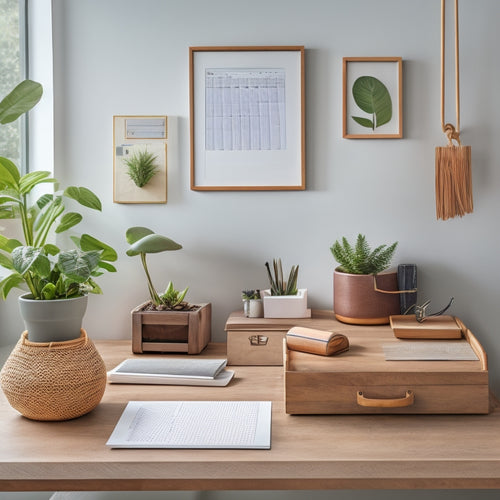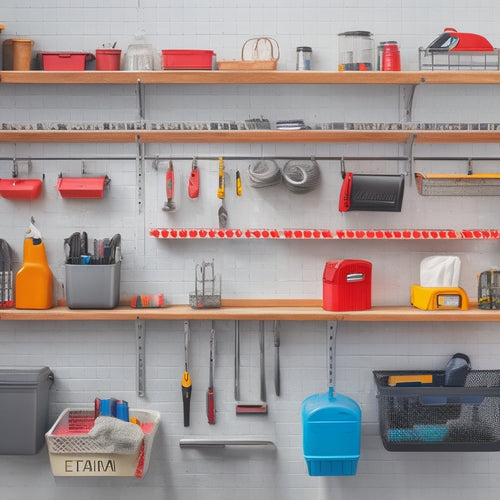
Tool Organization for Maximizing Space
Share
You're sitting on a wealth of tools, but they're scattered across your workspace, making it difficult to find what you need when you need it. To maximize your space, start by evaluating your tool collection, identifying must-haves, and prioritizing them based on frequency of use. Then, categorize and group similar tools together, keeping frequently used ones easily accessible. Design a customized storage system that employs vertical space, and implement a systematic approach to organizing tools for quick retrieval. By following these steps, you'll be well on your way to creating a streamlined workspace that saves you time and frustration - and there's more to uncover to take your organization to the next level.
Key Takeaways
- Assess toolbox contents to identify necessary tools, duplicates, and items for donation or sale, and prioritize tools based on frequency of use.
- Categorize tools into hand tools, power tools, and fasteners, and group similar tools together for easier access and storage.
- Design a customized storage system tailored to specific tool needs and workspace layout, using dividers and compartments to prevent tool damage.
- Maximize vertical space by installing shelf brackets, using wall hooks, and implementing pegboard solutions to store tools and supplies.
- Implement a routine for assessing the tool organization system to ensure efficiency, identifying areas for improvement, and making necessary adjustments.
Assessing Your Tool Collection
Your toolbox is likely a goldmine of gadgets and gizmos, but it's time to take stock of what you've got. It's crucial to assess your tool collection to guarantee you're making the most of your space.
Start by pulling everything out of your toolbox and laying it out on a flat surface. This will give you a clear view of what you have and help you identify any duplicates or unnecessary items.
Conduct a tool inventory to determine what you need, what you can get rid of, and what you can donate or sell. As you sort through your tools, consider the tasks you perform most frequently and the tools you use for those tasks. This will help you prioritize your tools and decide what to keep and what to discard.
Next, evaluate your toolbox's space to determine the most efficient way to store your tools. Consider the size and shape of your tools, as well as any specific storage requirements they may have.
Categorizing and Grouping Tools
With your tool collection laid out before you, it's time to impose some order on the chaos. This is where categorizing and grouping tools come in. Start by identifying the different tool types, such as hand tools, power tools, and fasteners. Within each category, group similar tools together, like all your screwdrivers or wrenches. This will make it easier to find what you need when you need it.
Consider the frequency of use, too - keep your most-used tools in easy-to-reach locations. As you categorize and group, think about the storage solutions that will work best for each type of tool. For example, you might use a pegboard for hanging tools like hammers and saws, or a bin for storing small parts and fasteners.
Designing a Storage System
By examining your categorized and grouped tools, you can now create a customized storage system that meets your specific needs. This involves selecting the right storage materials and shelving options to keep your tools organized, protected, and easily accessible.
Consider the size and weight of your tools when choosing storage materials. For instance, heavy tools require sturdy shelving, while smaller tools can be stored in bins or on pegboards. You may also want to use dividers or compartments to separate tools within a storage unit, preventing damage and making it easier to find what you need.
When selecting shelving options, think about the layout of your workspace and the frequency of tool use. Frequently used tools should be stored in easy-to-reach locations, while less frequently used tools can be stored on higher or lower shelves.
Additionally, consider using adjustable shelving to accommodate tools of varying sizes. By designing a storage system that caters to your specific tool collection, you'll be able to work more efficiently and safely.
Utilizing Vertical Space Effectively
Maximize your workshop's vertical space to avoid clutter and optimize tool organization. By utilizing wall space, you can free up floor space and reduce the risk of tripping hazards.
Install shelf brackets to hold bins, baskets, or containers filled with small tools and materials. Wall hooks are also great for hanging items like cords, hoses, or accessories.
Pegboard solutions provide a versatile and customizable way to store tools and supplies. You can hang bins, baskets, or pouches from the pegboard to keep items within easy reach.
Tool racks specifically designed for your most frequently used tools can also be mounted on the wall, keeping them organized and easily accessible.
Magnetic strips can be used to hold small metal tools, screws, or other metal parts, keeping them from getting lost or scattered around the workshop.
Maintaining Organization Over Time
You've optimized your workshop's vertical space, and now it's time to focus on maintaining that organization over time. This is vital to guarantee your tools remain accessible, and your workspace stays safe and efficient.
To achieve this, implement tool maintenance tips, such as regularly cleaning and lubricating your tools, and performing routine inspections to identify any damage or wear.
Seasonal organization strategies can also help you stay on top of your tool organization. For instance, consider storing winter-specific tools, like snow blowers, in a designated area during the warmer months, and vice versa. This will help prevent clutter and keep your frequently used tools easily accessible.
Additionally, establish a routine to regularly assess your tool organization system. This could be weekly, monthly, or quarterly, depending on your workshop's usage.
During these assessments, identify areas for improvement and make adjustments as needed. By maintaining your tool organization, you'll save time, reduce frustration, and guarantee a safe working environment.
Frequently Asked Questions
How Do I Deal With Tools That Have Multiple Functions or Uses?
You'll find it efficient to store multi-functional tools in designated areas, labeling each tool's various uses to avoid confusion, and utilizing storage solutions like dividers or bins to keep them organized and easily accessible.
Should I Store Tools by Frequency of Use or by Type?
Sort smartly, starting with self-reflection! You're torn between frequency-based storage, where often-used tools shine, and type-based organization, where similar tools stick together. Weigh your workflow: do you prioritize convenience or categorization?
Can I Use Old Furniture to Store Tools, or Buy New Storage?
You can repurpose old furniture as storage solutions, but consider the safety and durability of the piece before filling it with heavy tools; alternatively, buying new storage guarantees a sturdy and reliable option for your tools.
How Often Should I Clean and Maintain My Tool Storage System?
Did you know 64% of workplace accidents occur due to poor tool maintenance? You should establish a regular cleaning schedule, like weekly and monthly checks, and follow maintenance tips like labeling and categorizing tools to guarantee a safe and efficient storage system.
Are Tool Organizers With Small Compartments Worth the Extra Cost?
When deciding on tool organizers, you weigh the cost benefits of small compartments, which offer advantages like precise storage, reduced clutter, and increased accessibility, making the extra cost worthwhile for a more efficient and safe workspace.
Conclusion
As you stand in your newly organized workspace, you hold the reins of a well-oiled machine. Your tools, once a tangled mess, are now precision instruments, each one an essential cog in the machinery of your creativity. The walls, once bare, now bear the weight of your imagination, a representation of the power of intentional design. With every tool in its place, you're free to craft, to build, and to bring your vision to life. The organized space is a reflection of the clarity within, and the possibilities are endless.
Related Posts
-

Design Considerations for a Custom Pegboard
When designing a custom pegboard, you'll want to start by evaluating your storage needs, considering factors like too...
-

Best Organizing Tools for a Clutter-Free Space
You're on a mission to change your cluttered space into a peaceful oasis, and you're looking for the best organizing ...
-

3 Simple Steps to a Garage Tool Wall You'll Love
To create a garage tool wall you'll love, start by planning the space, taking inventory of your tools, and measuring ...


